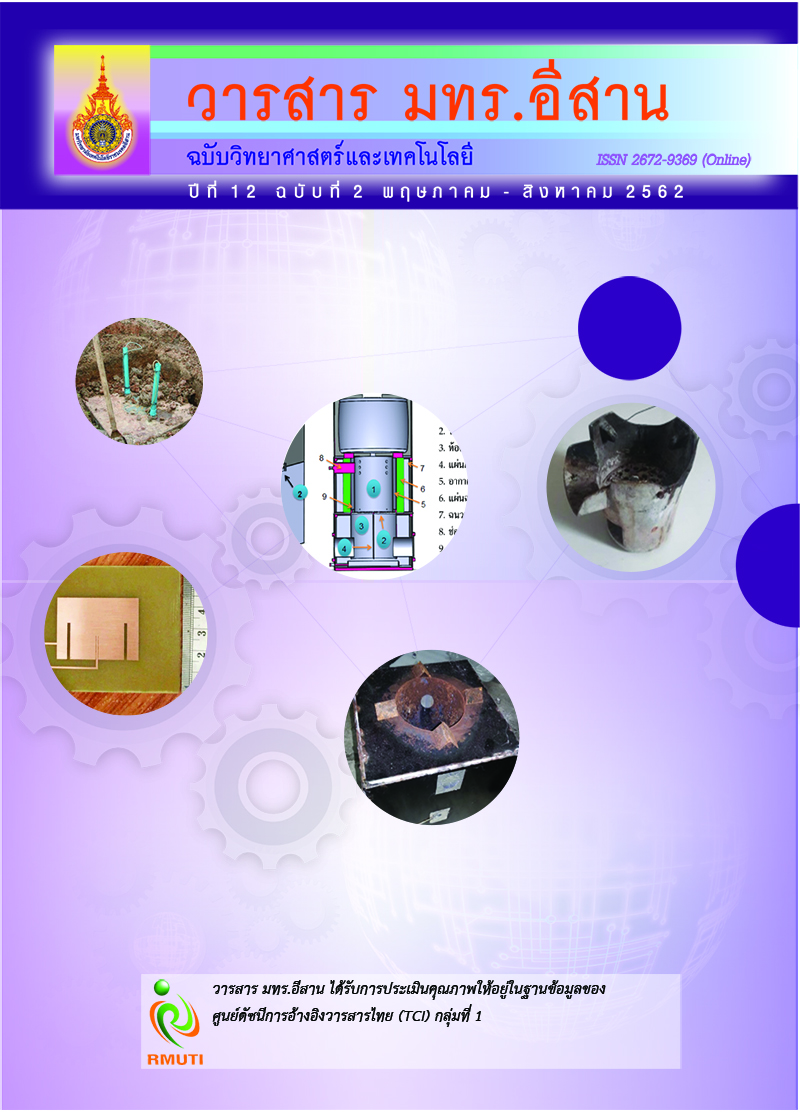Effect of Hydrocolloids on Quality and Stability of Halal Velvet Tamarind Jelly During Storage
Main Article Content
Abstract
The development of halal velvet tamarind jelly products was important for Muslim consumer confidence. The objectives of this study were to determine the effects of hydrocolloid on physical and chemical properties and to monitor stability of velvet tamarind jelly. The substitution of gelatin by carrageenan and pectin at 0, 50 and 100 % showed that gelatin substituted with 50 % carrageenan exhibited the highest overall likeness score which was 7.70 (like moderately). The water activity (aw) and pH of jelly products were 0.84 and 4.05. The stability of jelly samples packed inaluminium foil bag during 8 weeks at 4 oC was investigated. The total bacterial count was detected but it did not exceed the limitation of standards at 1 x 104 cfu/g. The overall likeness score was 6.81 (like slightly). From the results, 50 % carrageenan and 50 % gelatin could be used as ingredients for halal velvet tamarind jelly production.
Article Details
References
[2] Batu, A., Regenstein, J. M., and Dogan, I. S. (2015). Gelatin Issues in Halal Food Processing for Muslim Societies. Electronic Turkish Studies. Vol. 10, Issue 14, pp. 37-51. DOI: 10.7827/TurkishStudies.8928
[3] Adepoju, O. T. (2009). Proximate Composition and Micronutrient Potentials of Three Locally Available Wild Fruits in Nigeria. African Journal of Agricultural Research. Vol. 4, Issue 9,
pp. 887-892
[4] Chedoloh, R. (2018). Study on Post-Harvest Management of Fresh Black Velvet Tamarind and Dehydrating Methods on the Properties and Sensory Evaluation of Pre-processed Product. RMUTSV Research Journal. Vol. 10, No. 1, pp. 52-64 (in Thai)
[5] Ofosu, D. O., Opata, N. S., Gyampo, O., and Odamtten, G. T. (2013). Determination of the Elemental Composition of the Pulp, Seed and Fruit Coat of Black Velvet Tamarind (Dialium guineense) Using Instrumental Neutron Activation Analysis. Research Journal of Applied Sciences Engineering and Technology. Vol. 6, Issue 19, pp. 3536-3539. DOI: 10.19026/rjaset.6.3557
[6] Chedoloh, R., Niseng, Z., and Yoush, H. (2018). Development of Production Processes and Products to Increase Value Velvet Tamarind in Three Southern Border Provinces.
Bangkok, Thailand : The Thailand Research Fund. (in Thai)
[7] AOAC. (2000). Official Methods of Analysis of the Association of Official Analytical Chemists. 15th edition. Virginia: Association of Official Analytical Chemists
[8] Meilgaard, M., Civille, G. V., and Carr, B. T. (1999). Sensory Evaluation Techniques. 3rd edition. New York: CRC
[9] Teodorowicz, M., Neerven, J. V., and Savelkoul, H. (2017). Food Processing: The Influence of the Maillard Reaction on Immunogenicity and Allergenicity of Food Proteins. Nutrients.
Vol. 9, pp. 835-853. DOI: 10.3390/nu9080835
[10] Rattanapanone, N. (2002). Food Chemistry. 1st edition. Bangkok, Thailand: Odean Store
[11] Sunta, R. (2008). Development of Longon Chewy Candy Formulation. Ms. Food Science and Technology Department of Food Engineering, Graduate School Chiang Mai University. (in Thai)
[12] Lasztity, R. (2009). Food Quality and Standard. Oxford, United Kingdon, Vol. 1
[13] Nopchinda, S. (2014). Probiotics for Health Promotion. Journal of The Royal Thai Army Nurses. Vol. 15, Issue 3, pp. 430-435
[14] Supamiyotin, P. (2013). Fruit and Vegetable Technology. Bangkok, Thailand: Odean Store
[15] Sirisee, U. (2009). Substitution of Gums in Mulberry Jelly Part I: Application of Carrageenan to Replace Gelatin in Mulberry Jelly. Department of Food Science and Technology, Faculty of Science and Technology, Rajamangala University of Technology Tawan-ok (in Thai)
[16] Sato, M. F., Rigoni, D. C., Canteri, M. H. G., Petkowicz, C. L. O., Nogueira., A., and Wosiacki., G. (2011). Chemical and Instrumental Characterization of Pectin from Dried Pomace of Eleven Apple Cultivars. Acta Scientiarum Agronomy. Vol. 33, No. 3, pp. 383-389. DOI: 10.4025/actasciagron.v33i3.7125
[17] Sundarraj, A. A. and Ranganathan, T. V. (2017). A Review - Pectin from Agro and Industrial Waste. International Journal of Applied Environmental Sciences. Vol. 12, Number 10,
pp. 1777-1801
[18] Silva, R. S. G., Bandeira, S. F., and Pinto, L. A. A. (2017). Characteristics and Chemical Composition of Skins Gelatin from Cobia (Rachycentron canadum). LWT - Food Science and
Technology. Vol. 57, Issue 2, pp. 580-585. DOI: 10.1016/j.lwt.2014.02.026
[19] Webber, V., Carvalho, S. M. D., Ogliari, P. J., Hayashi, L., and Barreto, P. L. M. (2012). Optimization of the Extraction of Carrageenan from Kappaphycus alvarezii Using Response
Surface Methodology. Ciência e Tecnologia de Alimentos. Vol. 32, Issue 4, pp. 812-818. DOI: 10.1590/S0101-20612012005000111
[20] Thai Industrial Standards Institute. (2004). Thai Community Products Standards 519/2547: Soft Jelly. Bangkok, Thailand: TISI, Ministry of Industry. (in Thai)
[21] Dipiyoti, S. and Suvendu, B. (2010). Hydrocolloid as Thickening and Gelling Agent in Food: a Critical Review. Journal of Food Science and Technology. Vol. 47, Issue 6, pp. 587-597. DOI: 10.1007/s13197-010-0162-6
[22] Thai Industrial Standards Institute. (2004). Thai Community Products Standards 519/2547: Soft Jelly. Bangkok, Thailand: TISI, Ministry of Industry. (in Thai)
[23] Pye, J. (1997). Gelatin and Applications, pp 28-40. In S. Maneepan, ed. Symposium on Confectionery Technology. Food Science and Technology Association of Thailand. Bangkok,
Thailand. (in Thai)

